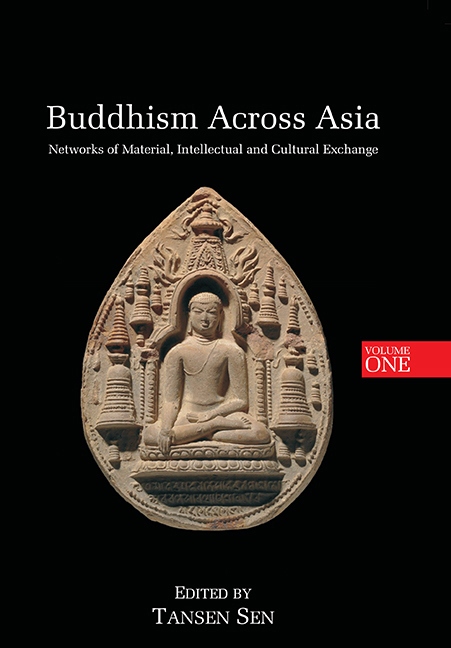Book contents
- Frontmatter
- Dedication
- Contents
- Introduction: Buddhism in Asian History
- Part I Tran smissions of Buddhism Before the Seventh Century
- 1 Networks for Long-distance Transmission of Buddhism in South Asian Transit Zones
- 2 Truth and Scripture in Early Buddhism: Categorial Reduction as Exegetical Method in Ancient Gandhāra and Beyond
- 3 Now You Hear it, Now You Don't: The Phrase “Thus Have I Heard” in Early Chinese Buddhist Translations
- 4 The First Āgama Transmission to China
- 5 What is a “Hīnayāna Zealot” Doing in Fifth-Century China?
- 6 Meditation Traditions in Fifth-Century Northern China: With a Special Note on a Forgotten “Kaśmīri” Meditation Tradition Brought to China by Buddhabhadra (359-429)
- 7 Transmission of the Dharma and Reception of the Text: Oral and Aural Features in the Fifth Chapter of the Book of Zambasta
- Part II Buddhism Across Asia between the Seventh and Fifteenth Centuries
- Part III Buddhist Connections after the Fifteenth Century
- List of Contributors
- Index
- Miscellaneous Endmatter
2 - Truth and Scripture in Early Buddhism: Categorial Reduction as Exegetical Method in Ancient Gandhāra and Beyond
from Part I - Tran smissions of Buddhism Before the Seventh Century
Published online by Cambridge University Press: 21 October 2015
- Frontmatter
- Dedication
- Contents
- Introduction: Buddhism in Asian History
- Part I Tran smissions of Buddhism Before the Seventh Century
- 1 Networks for Long-distance Transmission of Buddhism in South Asian Transit Zones
- 2 Truth and Scripture in Early Buddhism: Categorial Reduction as Exegetical Method in Ancient Gandhāra and Beyond
- 3 Now You Hear it, Now You Don't: The Phrase “Thus Have I Heard” in Early Chinese Buddhist Translations
- 4 The First Āgama Transmission to China
- 5 What is a “Hīnayāna Zealot” Doing in Fifth-Century China?
- 6 Meditation Traditions in Fifth-Century Northern China: With a Special Note on a Forgotten “Kaśmīri” Meditation Tradition Brought to China by Buddhabhadra (359-429)
- 7 Transmission of the Dharma and Reception of the Text: Oral and Aural Features in the Fifth Chapter of the Book of Zambasta
- Part II Buddhism Across Asia between the Seventh and Fifteenth Centuries
- Part III Buddhist Connections after the Fifteenth Century
- List of Contributors
- Index
- Miscellaneous Endmatter
Summary
The Rediscovery of Gāndhārī Literature
Recent years have witnessed a recovery of early Buddhist manuscript treasures from South Asia that, in scale and significance, can only be compared to the early twentieth-century discovery of a flourishing medieval Buddhist culture in monasteries and settlements along the Silk Roads in what is now Xinjiang (China), and to the discovery, in the 1930s, of a Buddhist manuscript deposit near Gilgit (Pakistan). Like the latter, the recent discoveries hail from the borderlands of Afghanistan and Pakistan, and, in many cases, predate previously known textual traditions by centuries. Many of the new manuscripts are in Sanskrit and written in varieties of the Brāhmī script, but the very earliest layer among them, dating from as early as the first century bce to the second century ce is written in the Kharos|thī script and in the local Middle Indo- Aryan language, Gāndhārī, with varying degrees of substrate influence from other dialects and, later, increasing Sanskritisation. At the outset of this paper,it will be useful to give a brief overview of Gāndhārī manuscript discoveries and of the currently known corpus of Gāndhārī literature since the available overviews have already been outdated by the rapid pace of events.
Until the 1990s, the only substantial Gāndhārī manuscript known to scholarship was the so-called Gāndhārī Dharmapada (now referred to as the Khotan Dharmapada), discovered in 1892 near Khotan on the southern Silk Road. This long birch-bark scroll apparently contained the complete text of a previously unknown version of the Dharmapada but only two-thirds of it survive and are now preserved in the Bibliothèque Nationale in Paris and in the Institute of Oriental Manuscripts of the Russian Academy of Sciences in Saint Petersburg. After a long series of preliminary studies, the Khotan Dharmapada was definitively edited by John Brough in 1962. Our only other sources for early Gandhāran Buddhism consisted of a limited number of Gāndhārī inscriptions (some containing literary and doctrinal references), archaeological and art-historical evidence, and the reports and translations of early Chinese pilgrims.
The situation changed radically when, in 1994, the British Library acquired a collection of twenty-nine birch-bark scroll fragments, and the Early Buddhist Manuscripts Project was established at the University of Washington to study these earliest remains of Buddhist and South Asian written literature.
- Type
- Chapter
- Information
- Buddhism Across AsiaNetworks of Material, Intellectual and Cultural Exchange, volume 1, pp. 19 - 38Publisher: ISEAS–Yusof Ishak InstitutePrint publication year: 2014



